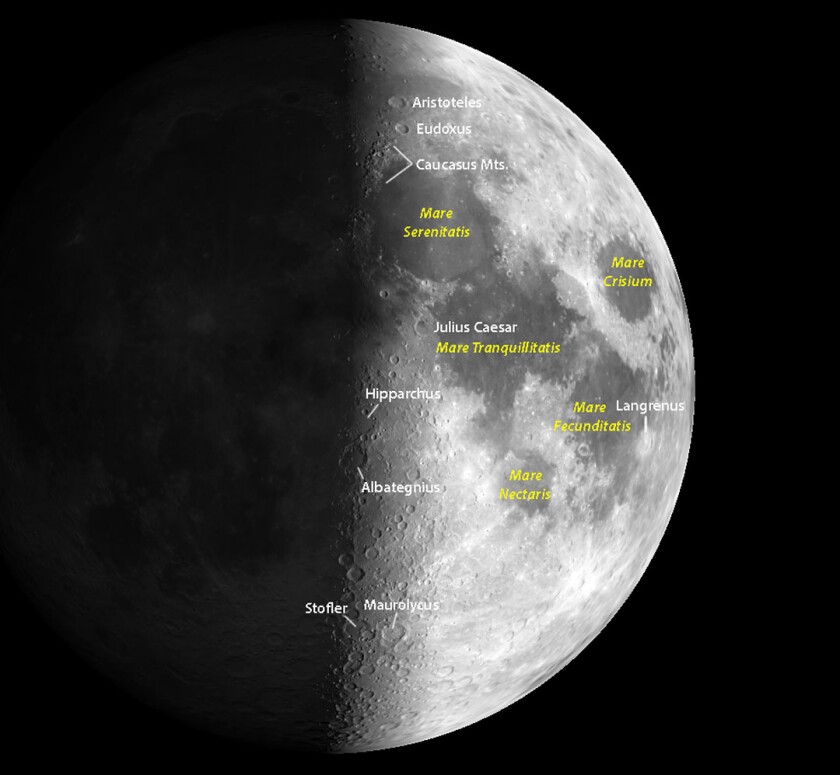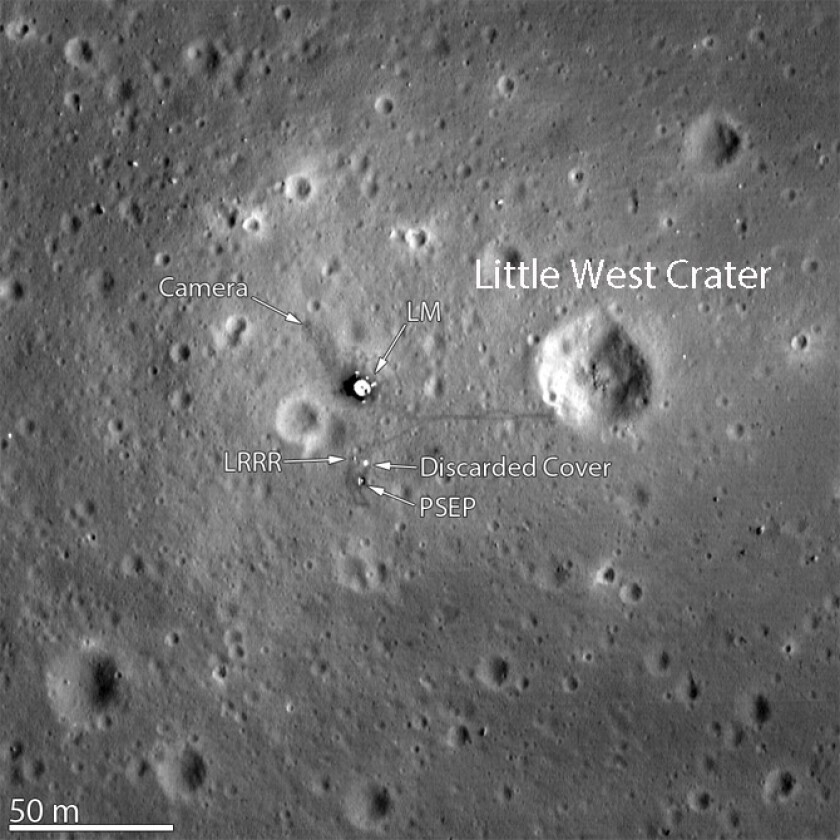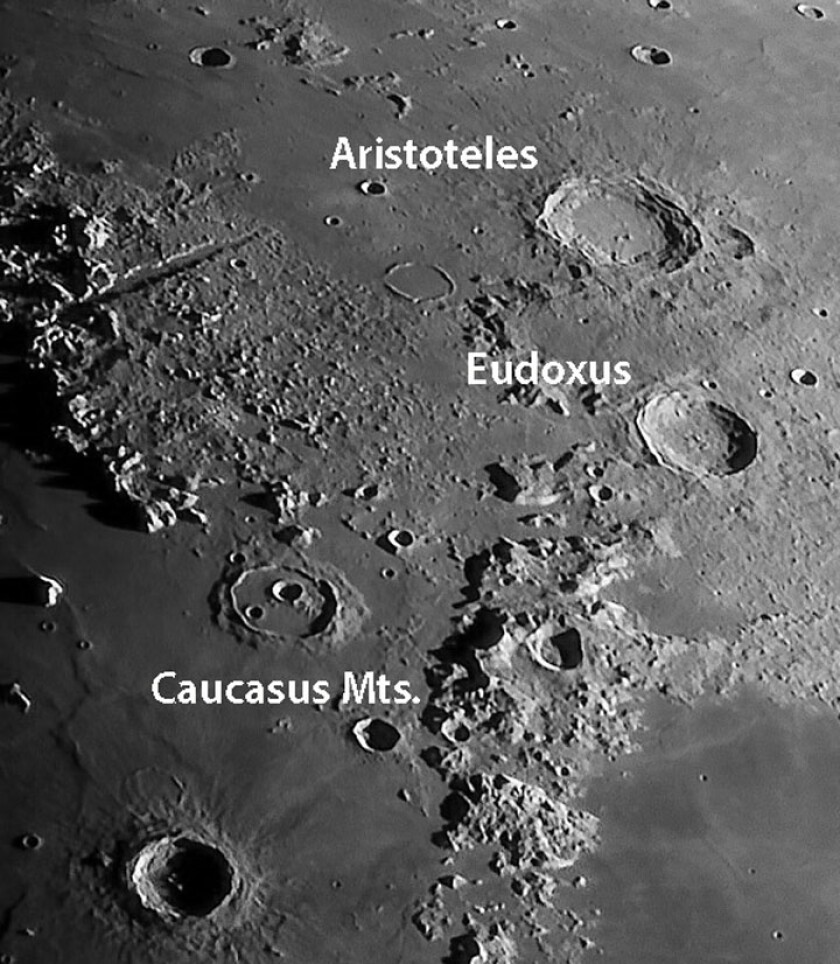By the time the moon's phase reaches half, it's bright enough to cast obvious shadows. On bitter cold nights the extra light is an incentive to step out for an evening stroll. The half-moon is also called the first quarter moon because it's traveled a quarter of the way around its orbit starting from new moon. First quarter phase occurs about seven days before full moon, while last quarter phase happens seven days after.
Tonight the moon will be in Pisces the Fish. Pisces is a long and stringy figure comprised of faint stars. Glare from moonlight will make it hard to see any of them with one exception. If you aim a telescope at the moon, you'll notice 5th magnitude Mu Piscium a short distance above its northern edge. They'll be closest together around 9 o'clock Central Time. From the far southern U.S. the moon will occult the star.

With your eyes alone, take a close look at the moon, and you'll see about half a dozen gray patches on its face. These are called the lunar seas (or maria, singular mare) and are enormous impact basins that formed 3.1 to 3.9 billion years ago when small asteroids slammed into the young moon. Later, magma from the lunar mantle flooded these deep basins which then cooled and solidified into lava plains.
ADVERTISEMENT

The seas or maria appear dark because they're rich in iron and titanium compared to the "white" parts of the moon called the lunar highlands. The highlands represent the original lunar crust and are rich in the lighter elements calcium and aluminum. When the moon was fully molten 4.4 billion years ago, the lighter magmas bubbled up to the top, cooled and became its "skin" or crust.
The moon offers so much to see compared to nearly every other solar system body, so why not get to know it better? We might plan a trip there — at least by sense of sight — the same way we scrutinize a map and other resources before a trip to the wilderness.
Naked-eye sights

How many seas can you see without optical aid? With the help of the map you should be able to make out Serenity, Tranquility and Fecundity easily enough. Mare Crisium (Sea of Crisis) and Mare Nectaris (Sea of Nectar) will take a little more concentration. Tranquility, the largest sea in view tonight and site of the first manned moon landing in 1969, is about 544 miles (876 km) across. Mare Nectaris is considerably smaller with a diameter of 210 miles (340 km) or about the distance from Boston to New York City.
Binocular highlights
ADVERTISEMENT

Binoculars reveal so much more including all the lunar maria, numerous mountain ranges and hundreds of craters. With a pair magnifying 8x-10x you'll see most if not all the craters I've annotated on the map. The pair of Aristoteles and Eudoxus, 54 miles (87 km) and 42 miles (67 km) across, respectively, stand out boldly near the top or north end of the moon. Just below them, look for the bumpy-textured Caucasus Mountains, which partially outline the "shore" of the Sea of Serenity. Julius Caesar lives on with a crater in his name located near the western edge of that sea.
Farther east, look for the ghostly oval Langrenus on the shore of Mare Fecunditatis. This 82-mile-wide (132 km) crater is named for Belgian mathematician Michel Florent van Langren, who drew the first annotated map of the moon. It appears washed out because at first quarter phase, the sun stands high in the sky over the moon's eastern edge. Shadows are short or non-existent. Without them the landscape, including craters, appears flat and without contrast.

Exactly the opposite is true along the moon's opposite edge — called the terminator — that runs straight up and down tonight. There, the sun is just starting to rise. The smallest features cast striking shadows which reveal exquisite detail especially through a telescope. The region is thick with craters, many of which overlap.
I labeled four of the largest: the north-south pair of Hipparchus (93-mile-diameter / 150 km across) and Albategnius (80 miles / 129 km) and the east-west duo of Stofler (78 miles / 126 km) and Maurolycus (78 miles / 114 km). Maurolycus is one of the more prominent lunar craters with big, wide walls and a floor that's 2.9 miles (4.7 km) deep. By the way, if it's cloudy tonight, all these features will still be visible on Monday night (Jan. 10), too.
For a casual look at the moon and its more prominent craters, it's fine to hand-hold your binoculars, but when you're trying to distinguish craters like Albategnius and Maurolycus in densely cratered highlands, a little support really helps. Arm movements and your own heartbeat make it difficult to hold binoculars steady. If you can't mount them on a tripod, try buttressing the pair against a wall or the roof or open door of your car. Once stabilized, you'll not only see more, but the view will be much clearer.
ADVERTISEMENT
Want to learn more lunar features? Sky and Telescope offers a free moon map download or you can get the free Moon Globe app for i Phone / iPad or Android .
"Astro" Bob King is a freelance writer for the Duluth News Tribune. Read more of his work at duluthnewstribune.com/astrobob .





